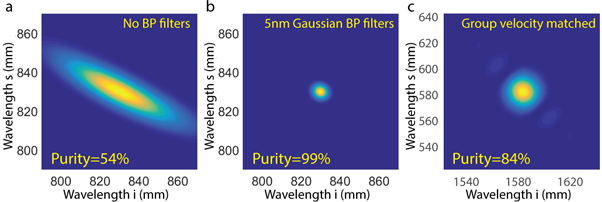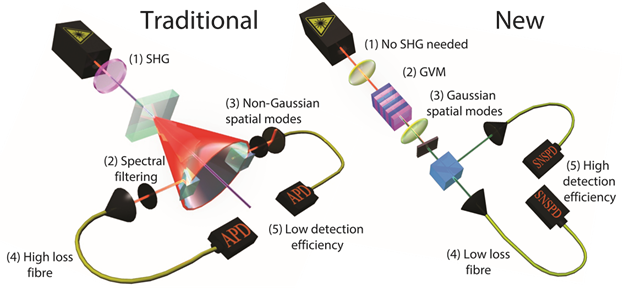Developing the tools to enable future quantum experiments and technologies
Physical systems with quantised properties allow us to experimentally demonstrate fundamental features of quantum mechanics and execute quantum information protocols. For us photons are the ideal choice as they travel at the speed of light, interact weakly with their environment, are easily manipulated, and are less prone to noise. At QOIL, we are developing methods to generate, manipulate, and detect single photons.
Photon pair generation
Over the past two decades, the most common approach to create photon pairs is spontaneous parametric down-conversion (SPDC). In SPDC, pump photons undergo a nonlinear optical process to create a down-converted photon pair. Here, one photon from the pair can be used to herald the presence of the other photon, an effective method for indicating when a single photon is present, provided the heralding efficiency is high, ideally 100%. Additionally, to perform multi-photon experiments (where photons are generated in several pairs) the photons must be able to interfere non-classically with high visibility. Perfect interference is only possible if the photons are indistinguishable, that is, they are identical in all degrees of freedom such as polarisation, frequency, bandwidth, space or time. To perform entanglement-based protocols, we rely on being able to generate high-quality and controlled entanglement in a chosen degree of freedom, in our case, polarisation. Unfortunately, virtually all photon-based quantum protocols have been limited by photon source inadequacies, channel loss and low detector efficiencies.
For the last two decades, the workhorses of photonic quantum information and communication have been bulk crystal SPDC sources. However, the past decade has seen the development of a new generation of photon sources that exploit recent advances in nonlinear optics. Quasi-phase matching via periodic poling overcomes many of the limitations of angle phase matched sources, which include lower heralding efficiencies and lack of control over spectral properties of down-converted photons. One can utilise comparatively long crystals in collinear geometries, yielding both higher photon pair generation and higher collection efficiencies.
QOIL’s high-performance photon sources
Our aim at QOIL was to develop a heralded single-photon and polarisation-entangled sources of high quality and efficiency. In traditional SPDC sources, bi-photons are born spectrally entangled (Figure a below). Photon counting measurements insensitive to this spectral information degrade the purity and indistinguishability of the state. The spectral information is typically erased by harsh spectral filtering of the state at the cost of both brightness and heralding efficiency (Figure b below). We use a more sophisticated approach to generate inherently pure bi-photons through engineering the down-conversion process itself, which involves group velocity matching (GVM, Figure c below).

Another limitation in experimental quantum optics is the photon detectors. While single photon quantum optics at the telecommunications wavelength was previously limited by the low quantum efficiencies and high dark noise of InGaAs APDs; recent advances in photon detection using superconducting nanowire single photon detectors (SNSPDs) have reported detection efficiencies of up to 93%. We currently have nine SNSPDs operating in our lab (more in the near future) obtained through our collaboration with the National Institute of Standards and Technology (NIST).

In the past, bulk crystal sources have been key to many photonic quantum information and communication experiments. The most common approach utilises non-collinear emission from type-II bulk Barium borate (BBO), or similar crystals, as shown in the above Figure (left). Our new source design (right) overcomes some of the key limitations of the traditional source design:
(1) the wavelength is directly accessible without the need for SHG;
(2) GVM, therefore no harsh spectral filtering required;
(3) used quasi phase matching for a collinear geometry with optimised coupling modes;
(4) down-conversion in the telecom wavelength range where the fibres are low loss; and
(5) SNSPDs operate with detection efficiency up to 90%, as opposed to APDs which typically operate around 55%.
What the numbers say
Our new source is the first entangled SPDC source that simultaneously possesses high purity, heralding efficiency and high-quality polarisation entanglement. We measure (82±2)% non-classical interference visibility between independent photon sources with no filters, and (100 ± 5)% with just 8 nm bandpass filters (Figure below). For our polarisation entangled Sagnac source, with 8 nm bandpass filters, we measure a Bell state fidelity of (99:0 ± 0:2)%, a tangle of (97.1 ± 0:4)%, and a purity of (98.0 ± 0:2)%. The unentangled source configuration has achieved symmetric heralding efficiency up to (82 ± 2)%. These are remarkable results in comparison to the traditional source design which requires a 3 nm bandpass filter to achieve a non-classical interference visibility of ≈ 93% between independent photons and have heralding efficiencies limited to ~20%.
